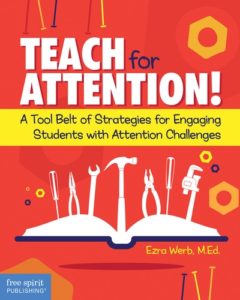Building Confidence in Students with ADHD

People are talking a lot more about ADHD.
In the last few years, many more parents have approached me with questions and concerns about their kids’ attention issues, and more adults have told me that they’ve either been recently diagnosed or were diagnosed as a child.
Even celebrities like Simone Biles, Adam Levine and Emma Watson have talked to the press about their ADHD. I believe this all helps to minimize the stigma.
At the same time, those four letters continue to evoke a ton of emotion in teachers, parents and kids. Students with significant attention challenges can struggle greatly in the classroom, and teachers often don’t have the training to support them.
There is a lens through which we can look at students with ADHD that may help give teachers a specific direction. In my years of working with students with learning and attention challenges, I’ve seen how anxiety and confidence can be crucial factors in a student’s success.
ADHD and Executive Functions
Let’s back up a bit.
ADHD has two different types as described in the DSM-5: inattentive type and hyperactive/impulsive type. Someone may be diagnosed, depending on the observable symptoms, with one or both types. You’ve seen the symptoms in a classroom:
- Looking everywhere but at the teacher.
- Difficulty getting started on work.
- Unfinished assignments.
- Sloppy writing.
- Messy desks.
- Homework left at home.
- Not being able to answer questions.
- Impulsive behavior.
This is just a sample of what we may see on the outside. But what lies underneath?
In the last few years, I’ve heard the phrase executive functions more often in meetings with teachers, parents, and administrators. More websites are posting blogs trying to concisely sum up what these functions are and how they affect students.
I’ve also noticed that people tend to simplify executive functions as being mainly an issue with organization and/or self-control. Sure, these are components, but only pieces of a much bigger picture.
Dr. George McCloskey, a leading neuropsychologist in the field, lists 24 self-regulation executive function capacities that you could use to develop a profile of someone’s strengths and deficits. Some of these include the following abilities:
- to perceive
- to hold
- to inhibit
- to sustain
- to modulate
- to foresee/plan
- to regulate pace
- to employ time awareness
All of these, according to McCloskey, are involved in how we perceive, feel, think or act. And that’s only eight of the 24. You can imagine the sorts of challenges a student would face if even just these eight functions were weaker. So much is asked of our students on a daily, hourly, even minute-to-minute basis that requires mental activity.
How could a student with the symptoms described above not feel anxiety? How could s/he have any confidence in the classroom? Speaking for myself, when I don’t have confidence—when I’m anxious—I back away. I withdraw.
I disengage.
Raise Confidence, Lower Anxiety
Let’s bring this back to where we started.
As an educational therapist working one to one with struggling students, my approach is to foster incremental successes, lower anxiety and build confidence. I see consistently how setting up situations where students can feel confident—where they can take a step forward, no matter how small the step—can reduce their anxiety and make them feel more capable to approach new learning and tasks.
So how do we accomplish this in our classrooms? How do we make students feel less anxious and more confident, in spite of their executive function and attention challenges?
Here are just a few strategies I discuss in my book, Teach for Attention!: A Tool Belt of Strategies for Engaging Students with Attention Challenges.
Include Students’ Interests
The first chapter of my book is all about how to use students’ personal interests in the classroom. Dr. Robert Brooks, a psychologist specializing in people with disabilities, coined the phrase “Islands of Competence” to describe the areas where people with disabilities can excel and feel confident. These “islands” are unique to every person. When thinking about our students, this can simply be their favorite TV shows, sports teams/athletes, video games, music or movies. They know all about this stuff, and talking about it makes them feel comfortable and self-assured.
I’m not suggesting you study Super Mario Bros. in class.
What you can do is find opportunities to reference the things they love and find ways to relate whatever you’re teaching to their interests.
Here’s an anecdote.

But I knew he was a huge sports fan. I asked him if he thought data and probability had any relation to sports. He agreed.
We talked about NBA scoring averages and baseball batting averages, and suddenly, he was engaged with the concepts. He was smiling, the first time I’d ever seen that while he was doing math. We then worked on problems similar to those he needed to do for homework, but we used sports statistics. Connecting the math to sports was the key to lowering his anxiety, allowing him to feel ready to grapple with the challenging work.
Alleviate Reading Stress with Strategies/Technology
Reading novels is so often a great challenge for students with attention issues. There is just so much text and meaning to digest, whether it be a novel, a chapter in the history textbook or even an article online. And often students have concurrent language processing challenges.
Here are some strategies you can use to reduce anxiety and boost confidence.
1. Frontload Story Elements – Before having a student jump into a novel, find a PowerPoint online or simply find images that introduce the main characters, plot and setting. It’s like showing them a movie trailer. I’ve found that knowing what to expect, in terms of characters and plot, helps students feel more confident when starting books. You could also do this before assigning a textbook chapter for homework—give them a quick preview of the sub-headings they’ll be reading about.

3. Use Audiobooks – Studies have shown that listening to audiobooks develops comparable language comprehension skills as visual reading. I’ve had multiple students struggle greatly with Lord of the Flies due to its dense passages, but when they listened to the audiobook while following along in the text, they overcame it. Audiobooks can reduce reading anxiety right from the start.
Build Incremental Writing Success
Your struggling students may not be ready to write a five paragraph essay. Let’s build them up to that with incremental victories.
1. Graphic Organizers – Blank pages can be so anxiety provoking. Before they attempt a sentence, have students brainstorm into an organizer – a bubble map, T-chart, whatever. Just get them jotting some ideas down and let this be the first step.
2. Step Charts – Brainstorming can be step one, but let’s chop up those bigger writing tasks into smaller steps. Maybe just coming up with a thesis and making an outline is step two. An opening paragraph is step three. However you chop it up, allow students to feel accomplished with these smaller tasks they can complete to help build their confidence.
3. Set Realistic, Reachable Goals – If five paragraphs provoke too much stress, set a goal that’s closer to the student’s current ability. It’s okay to allow them to tackle only three paragraphs this time. Or less, even. The point here is to build them up to the ultimate goal by proving to them that they can reach writing goals, and it’s okay if it happens incrementally.
The Big Takeaway
Engaging our students with attention challenges should be our ultimate goal. With lowered anxiety and increased confidence, they’ll be more ready to raise their hands, intake new information and attempt more challenging tasks.
Remember, small successes are like stepping stones.
Help students take one step at a time.

Ezra earned his master’s in special education with a concentration in educational therapy from Cal-State Northridge and is a member of the Association of Educational Therapists. He lives in Boston, Massachusetts, where he works in private practice with students with ADHD, spectrum disorders, dyslexia, anxiety, and other learning challenges. He is the author of Teach for Attention!: A Tool Belt of Strategies for Engaging Students with Attention Challenges (Free Spirit Publishing, 2019).






































Thank you for your insight. Given the reality of how complex it is to reach certain students, do you believe there should be guidelines and limits on classroom size in order to ensure we have the time and resources necessary to try different approaches specifically targeting our ADHD students? I have had classes with multiple students needing a variety of modifications and I have to be honest in admitting that if my classes had been smaller I could have done more to reach everyone. I did not make as much of an impact for some of my students as I would have liked. Thank you for your thoughts Ezra.
This is an important topic—class size for students with ADHD and other learning challenges. Thank you for the comments and questions, Pietro.
I would always endorse smaller class sizes, in general, for any students. But specifically for students with attention challenges—In nearly two decades of working in classrooms, I’ve seen class sizes grow, and it’s always at the expense of teacher attention to individual students who most need support. So I empathize with your situation.
Sadly, teachers rarely have any say in how big their classes are, even when they make a logical case, as you’ve done in your comment.
I know how difficult it is for teachers to differentiate and accommodate for a couple of students when there are 25-40 other students in the class. This is why the strategies I suggest in my book and in my article aren’t ones that take long to prep or implement.
All of that said, don’t stop fighting for smaller class sizes! Talk to your administrators—make your case for why classes with students with challenges would be more effective for everyone if they were smaller sized.